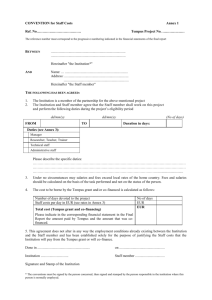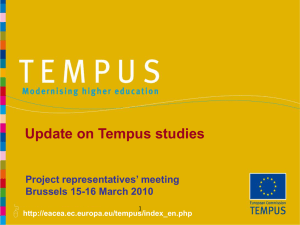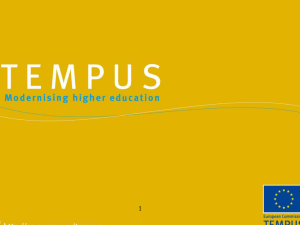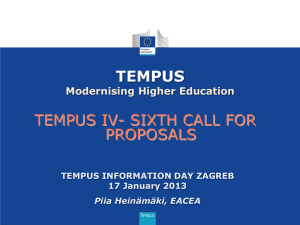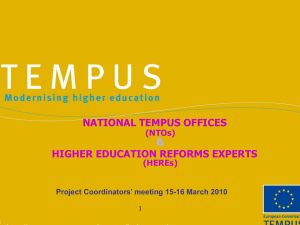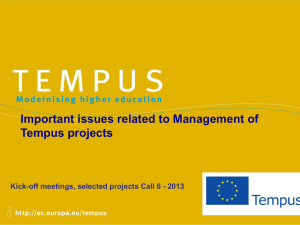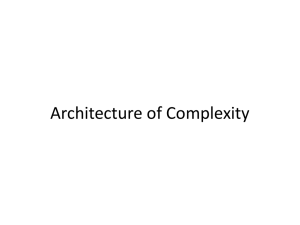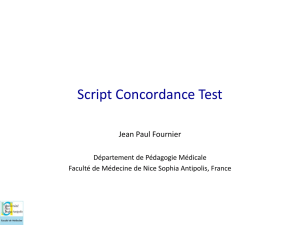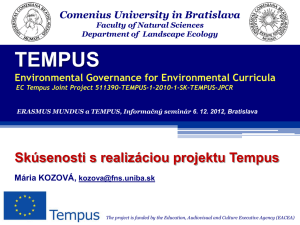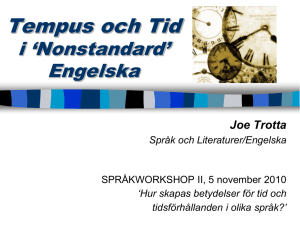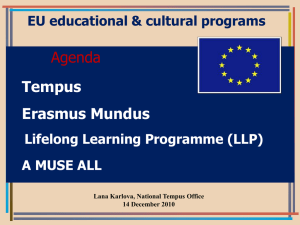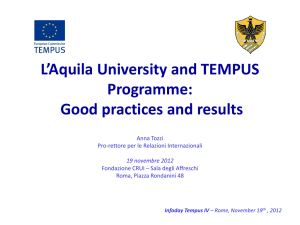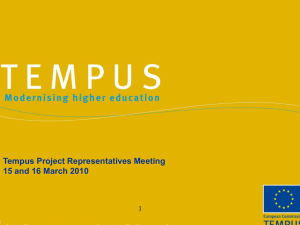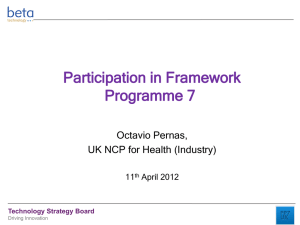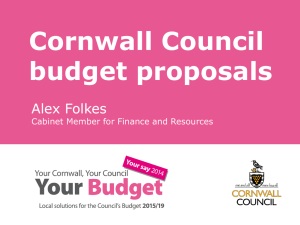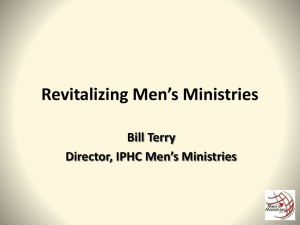Joint Projects
advertisement
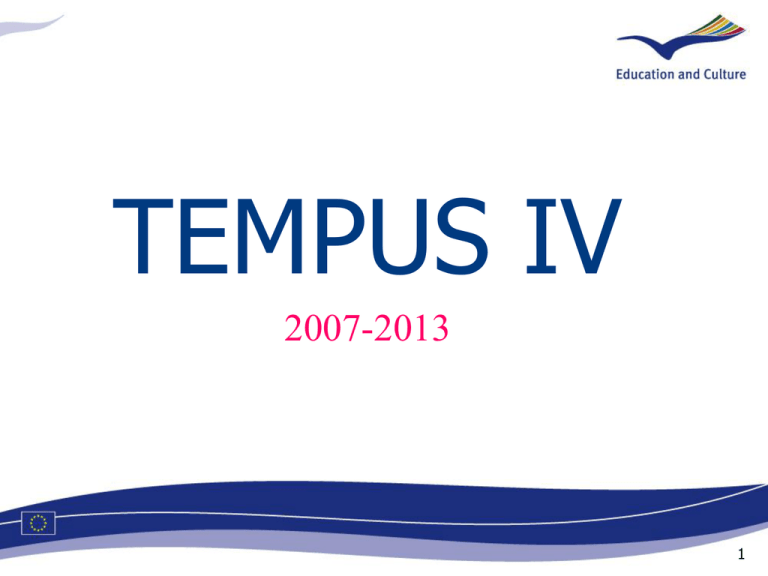
TEMPUS IV 2007-2013 1 Basic features (I) • Objective: to establish an area of cooperation and modernisation in higher education between the European Union and the partner countries in the surrounding area, including Central Asia • Geographical coverage: 27 partner countries in the Western Balkans, Eastern Europe, the Mediterranean and Central Asia • Programme focusing on institutional cooperation • Bottom-up programme mainly implemented through calls for proposals complemented by structural measures targeting higher education systems Tempus IV 2 Basic features (II) • Strong involvement of national authorities in the definition of priorities and selection of projects • Programme supported by a network of National Contact Points in EU Member States and National Tempus Offices in partner countries Tempus IV 3 Basic features (III) • Tempus IV finances two types of projects through calls for proposals • Joint Projects • Structural Measures (through call for proposals) (+ direct support to Ministries) • Accompanying Measures (tenders/framework contracts) Tempus IV 4 Joint Projects (I) Joint Projects implemented at institutional level can do the following: 1- Curricular reform: • adapt, modernise and restructure existing curricula with a focus on content, structure, teaching methods and the use of new teaching materials. • establish study programmes with a double or multiple degree or a joint degree; • establish links with the labour market. Tempus IV 5 Joint Projects (II) 2- Governance reform: • modernise the capacity, management and governance of higher education institutions • promote a quality assurance culture Tempus IV 6 Joint Projects (III) 3- Higher education and society: • strengthen the role of higher education institutions in society at large • address the "knowledge triangle" of education, research and innovation (project must not focus on research) • encourage links between higher education institutions and the labour market Tempus IV 7 Structural Measures Projects implemented at national level for the development and reform of the national higher education structures and systems in the partner countries : 1- Governance reform (licensing, accreditation, qualification frameworks, quality assurance, autonomy…) 2- Higher education and society (links between different sectors of education, with the world of work, capacity building for public administration…) Tempus IV 8 Budget for the 2007 call • Eastern Europe: € 24 million (incl. 10 for Russia) • Mediterranean region: € 14 million • Western Balkans: € 19,55 million (Serbia:7 – Fyrom: 3.5 - Croatia: 3 – BiH: 2,4 – Kosovo: 1.8 – Albania: 1.05 – Montenegro: 0.8) • Central Asia: € 5 million – 1 M€ per country Tempus IV 9 Grant size and project duration • Both for Joint Projects and Structural Projects • From € 500,000 to € 1,500,000 • Minimum grant size for countries with annual budgets below € 1 million: €300,000 (Albania, Montenegro, Central Asia) • Project duration: from 24 to 36 months Tempus IV 10 New elements (I) • No longer a “Guide for Applicants” with four parts but one call for proposals with annexes • Guidance to fill in the application form (Part 4 of former Guide for Applicants) is now integrated into the application form • No more Individual Mobility Grants • No more Complementary Measures • Larger projects with more partners (small projects targeting one university will not be funded anymore) Increase of grant size • Introduction of a new type of Structural Measures for Ministries of Education only (direct grants – not subject of the call for proposals) Tempus IV 11 New elements (II) • Programme-wide and national priorities are compulsory • New partner country: Israel • Participation on self-financing basis: Turkey and EFTA countries only • EU applicants must have adhered to the Erasmus University Charter • Universities in Partner Countries can act as grant applicants • Involvement of non academic partners is encouraged • Teacher and student organisations can be involved as partners and applicants • Involvement of students or their organisations throughout the project life is encouraged Tempus IV 12 New elements (III) • No threshold for staff costs anymore: proof of cost-effectiveness instead • Student mobility: maximum 3 months to avoid overlap with Erasmus Mundus/ECW (mobility must be recognised) • More emphasis on dissemination and sustainability • Programme centrally managed by the Executive Agency for Education, Audiovisual and Culture in Brussels under the leadership of the European Commission • Executive Agency responsible for entire project cycle including contracts and payments Tempus IV 13 New elements (IV) Conditions for non-eligibility have been reinforced: • legal entities which have managed a Tempus project in the past two years which has been terminated by the Commission may not apply for a grant; • proposals which are obviously "copied" and just include different partners and another partner country are not eligible. Tempus IV 14 Programme priorities (I) • • • • Strict adherence to national priorities for national projects Programme-wide priorities and project types are defined around the EU higher education modernisation agenda (3 blocks) National priorities defined by the Ministries of Education (selected from the programme-wide priorities) both for Joint Projects and Structural Measures Re Curricular development for Joint Projects, specific academic disciplines were identified Tempus IV 15 Programme priorities (II) Block 1: Curricular reform • Introduction of the three cycle system • ECTS and recognition of degrees • Modernisation of curricula (+ national priorities for academic disciplines) Tempus IV 16 Programme priorities (III) Block 2: Governance reform • • • • • University management and services for students Introduction of quality assurance Institutional and financial autonomy and accountability Equal and transparent access to higher education Development of international relations Tempus IV 17 Programme priorities (IV) Block 3: Higher education and society • Training of non-university teachers • Development of partnerships with enterprises • Knowledge triangle education-research-innovation • Training courses for public services (ministries, regional/local authorities) • Development of lifelong learning in society at large • Qualification frameworks Tempus IV 18 Kosovar priorities in disciplines • Engineering, Hard Sciences and Biotechnical Sciences, Social Sciences 19 Timetable • March. 2007: Publication of first call for proposals + application form in EN, FR, DE • April 2008: Deadline for the submission of proposals • June - July 2008: Evaluation procedure • Aug - Sept 2008: Consultation procedure • October 2008: Selection panel • November 2008: Publication of results (approx 80 projects funded) • December 2008: Contracting and pre-financing Tempus IV 20 Evaluation procedure • Quality and feasibility of proposals evaluated by independent academic experts • Technical and financial evaluation independent academic experts • Consultation of national authorities, EC Delegations, National Tempus Offices • Results of the evaluation procedure final ranking, grant award decision Tempus IV 21 Priority given to proposals that: • • • • • • Involve a representative number of higher education institutions from a partner country Involve non-academic consortium members Promote interregional cooperation activities Demonstrate that they actively involve students or their organisations Demonstrate a strong institutional and individual capacity building process Demonstrate a wider impact on higher education institutions and systems Tempus IV 22 Eligible partnerships for national projects • At least two higher education institutions, each from a different EU Member State • At least one academic or non-academic partner from a third EU Member State (new) • At least three higher education institutions from the partner country (in the case of Montenegro, Kosovo and FYROM one institution is sufficient) Tempus IV 23 Eligible partnerships for multi-country projects • At least two higher education institutions, each from a different EU Member State • At least one academic or non-academic partner from a third EU Member State (new) • At least one higher education institution from each partner country Tempus IV 24 Eligible partners • State-recognised higher education institutions from the EU and the partner countries • Associations and networks of higher education institutions • Public authorities (ministries or national/regional administrations) • National and international rector, teacher and student organisations • Non-governmental organisations • Social partner and their training organisations • Private and public enterprises Tempus IV 25 Applicants • must prove their operational capacity: CVs of project team and list of projects already undertaken in the relevant field • must prove their financial capacity: profit and loss accounts of the last three years (public bodies are excepted from this proof) Tempus IV 26 Eligible costs for Joint Projects and Structural Measures • At least 5% co-financing Eligible costs : • • • • • Staff costs (no more ceiling) for academic and admin staff Travel and subsistence Equipment (max. 30%) and supplies Printing and publishing 7% administrative costs Tempus IV 27 Eligible activities for Structural Projects • • • • • Surveys and studies policy and expert advice; organisation of conferences, seminars, workshops, round tables staff training on policy issues awareness raising campaigns. The Ministry of Education must • • directly participate in the project, or formally endorse the projects’ objectives and activities Tempus IV 28 Two other types of actions under Tempus IV • Direct support to the Ministries of Education to promote higher education reforms • Accompanying Measures funded through calls for proposals, calls for tender or framework contracts dissemination and information activities such as thematic conferences, studies Tempus IV 29 Thank you for your attention ! More on http://ec.europa.eu/tempus http://ec.europa.eu/erasmus-mundus http://eacea.ec.europa.eu/extcoop/call/index.htm 30
